NOKIA TECHNOLOGIES PC0100 OZO Professional VR Camera PC-01 User Manual OZO QG 145x145 PRESS LEGAL EDIT indd
Nokia Technologies Ltd OZO Professional VR Camera PC-01 OZO QG 145x145 PRESS LEGAL EDIT indd
User Manual


Index
Box Content 4 - 5
WARNINGS
Ventilation 7
Overheating 8
Operating and Storage Temperature 9
Protective Cover 10
Safety and Handling 11
General Warnings 12 - 13
BASICS
Device Handling 15
Mounting 16
Changing the Tripod Adapter 17
Connector Cap Removal 18
Connecting Power 19
Connecting SDI 20
Cartridge Replacement 21
Charging Battery 22
Extracting Data 23
OZO Applications 24
Basic Operation 25 - 26
WARRANTY AND LEGAL
Warranty 28 - 29
Regulatory and Safety Notices 30 - 31
Recycling 31
MAKING VIRTUAL REALITY
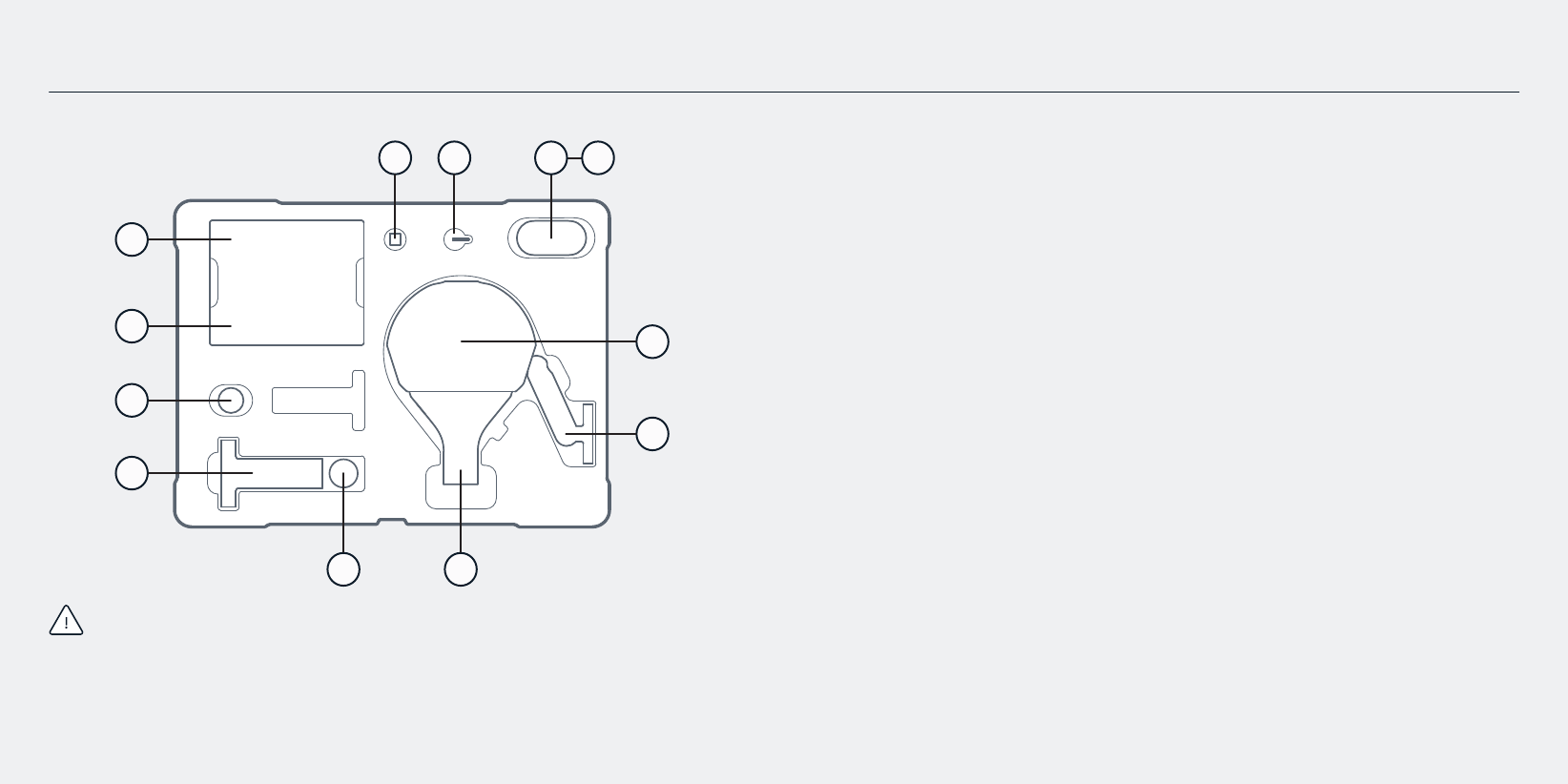
Box Content
1. ProtectiveCover(comesttedtocamera)
2. Largetripodadapter(comesttedtocamera)
3. OZO Professional VR Camera PC-01
4. Media Cable MC-01, for USB3 data transfer to computer directly from Media
Module or cartridge in Docking Station.
5. Docking Station DS-01, for battery charging and data transfer
6. Small tripod adapter
7. Camera External AC power supply and AC cables
8. Docking Station AC power supply and AC cables
9. 3G-SDI adapter card in protective ESD bag, for external recording/
monitoring
10. T6 tool, for removing Connector Cap of power/SDI slot
11. Digital Cartridge DC-01, including 33Wh Li-Ion rechargeable battery
12. Media Module MM-01, including 500GB solid state storage
NOTE:Duetothesizethecaseshouldtravelasholdluggagewhenyingwith
OZObutthecartridges(containingLi-Ionbatteries)shouldberemovedand
carried as hand luggage according to international regulations.
9
5
10
7
6
4
2
1
3
5
8
The Protective NANUK 950 carrying case is intended for normal transportation
of OZO and included accessories. Please keep the cardboard shipping box and
packing, and reuse when transporting the camera by courier or shipping agent.
11 12
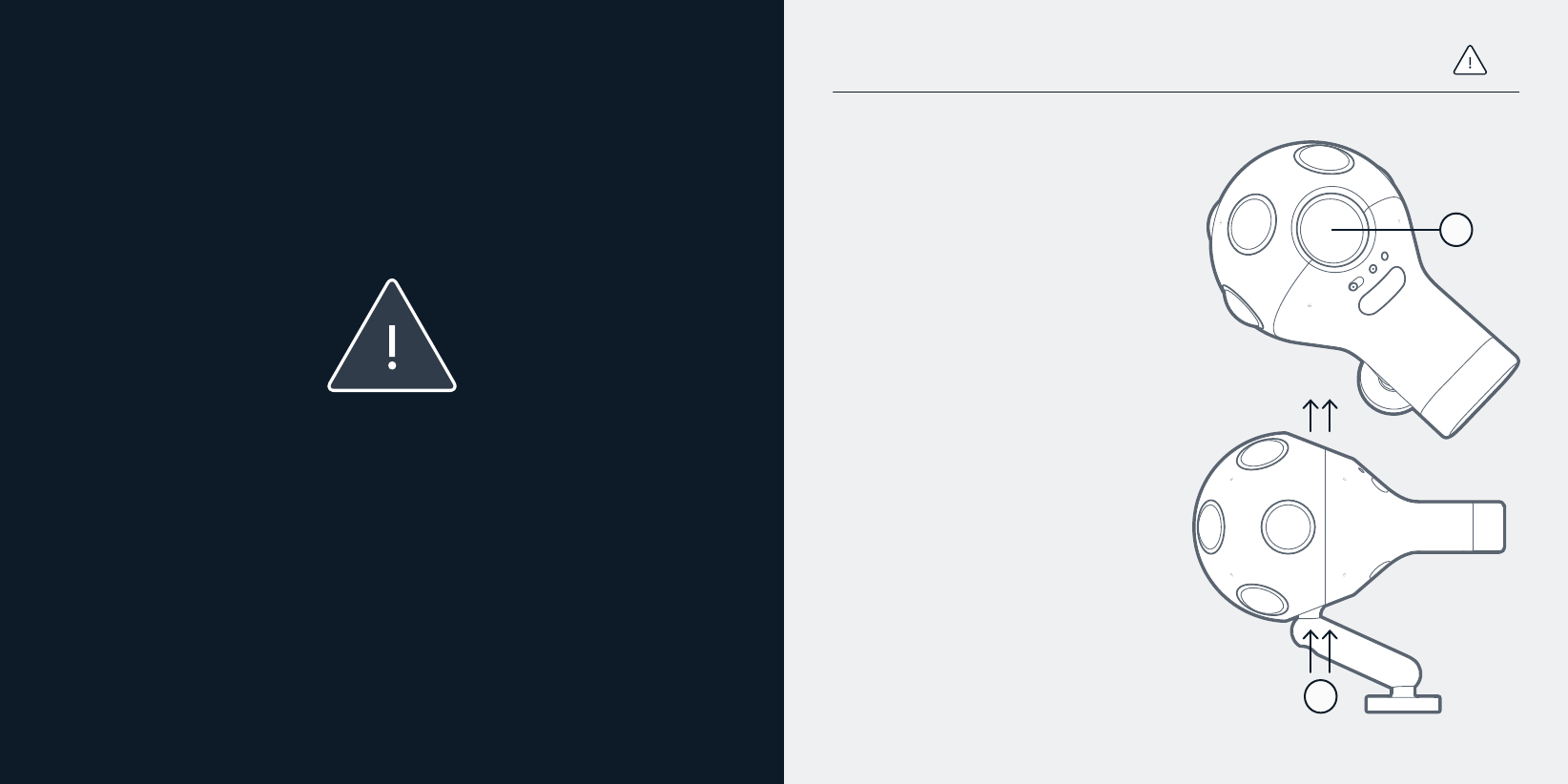
Ventilation
Do not cover the ventilation opening
(A).
TheDeviceiscooledbyairowing
between the outer and inner
structure.
Keep the device ventilation upright
(B).
Covering the opening or mounting
the device in a way that the
openings are not vertically on top
of each other would prevent the air
fromowing.
WARNINGS
7
B
A
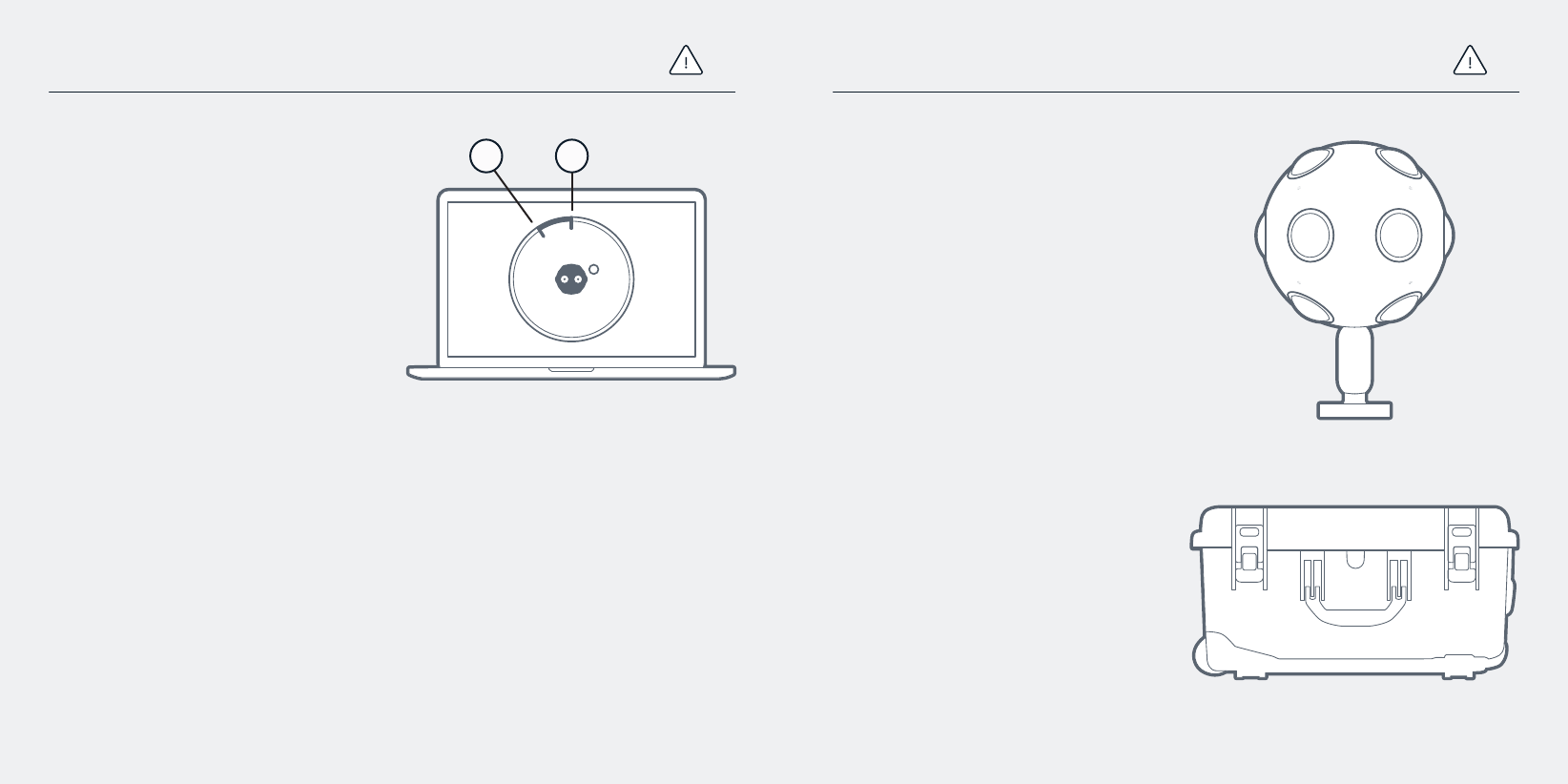
Overheating
Capture or broadcast will stop on
overheat
The Device is protected against
overheating by switching to standby
when the temperature of the device
exceeds a set limit (A).
Switching to standby discontinues any
kind of capturing because the sensors
are powered down.
If the temperature continues to
rise even after switching to standby
a second threshold triggers full
shutdown (B).
Do not use near heat sources.
These may cause the device to
overheat, and stop capture.
Operating and Storage Temperature
Operating Temperature
The device should only be used
between +32°F and +77°F (0°C and
+25°C).Donotuseoutsidethisrange.
Storage Temperature
The device should be stored between
-4°Fand+122°F(-20°Cand+50°C).
Do not store outside this range.
98
+32°F / +77°F 0°C / +25°C
-4°F / +122°F -20°C / +50°C
BA
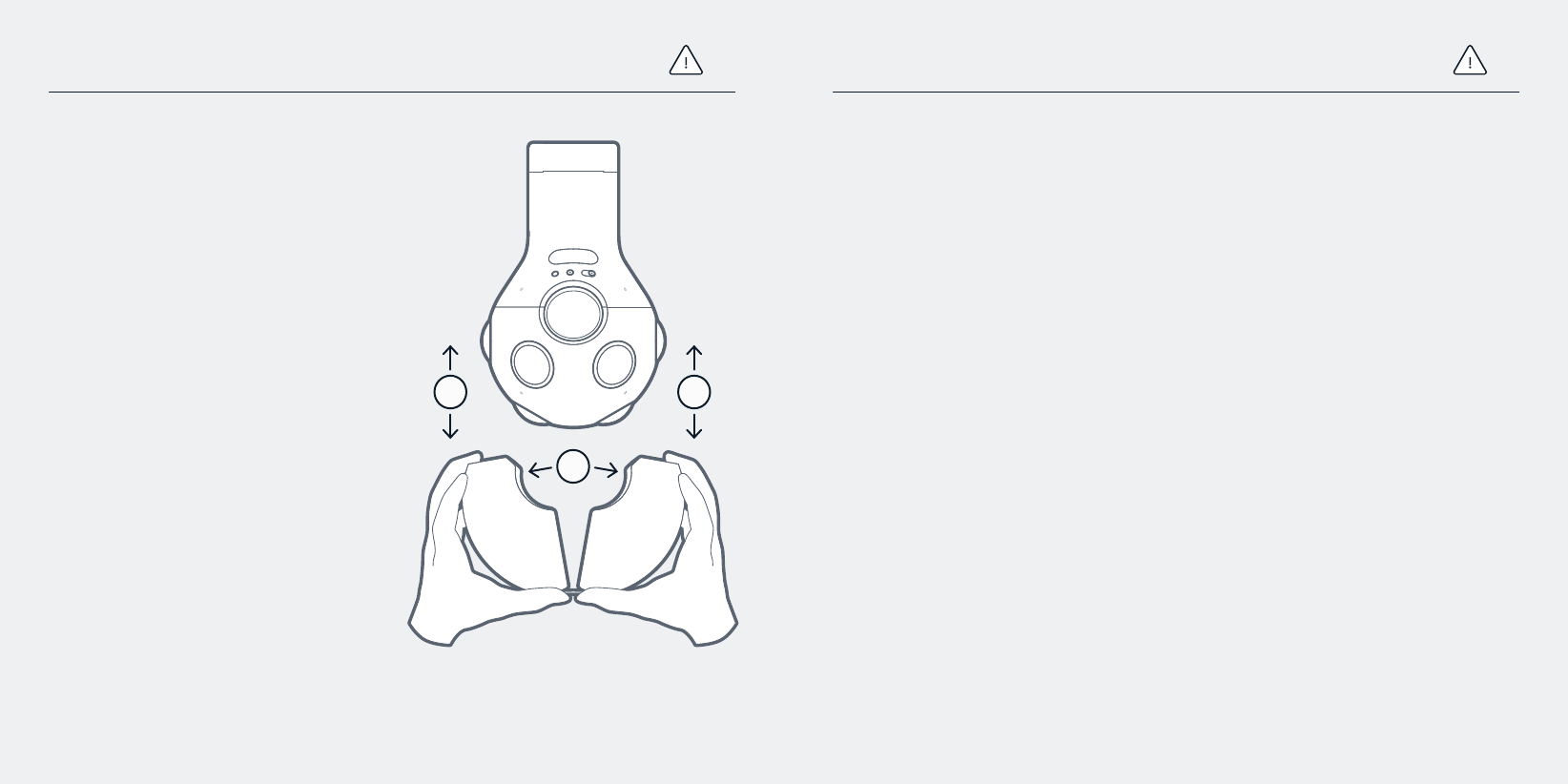
Protective Cover
Do not remove the protective cover
until the device is fully mounted.
Keeping the protective cover on
the device for as long as possible
decreases the risk of lens damage
signicantly.
To remove or attach the cover, open
it only the necessary amount.
Avoid contact with the lenses as
much as possible.
1
10 Safety and Handling
Handle with care
Thedeviceweightis4.2kg(9.3lbs)
including the digital cartridge.
Do not lift the device by holding the
protective cover or cartridge.
Do not manipulate the device without
the protective cover.
Care should be taken when moving
the device.
Do not place or mount the device on
unstable objects.
To avoid damage to the device,
remove and insert the Digital
Cartridge according to the
instructions given in the section
“Cartridge replacement” p. 21.
To avoid damage to the 3G-SDI card,
attach and remove SDI cables according
to the instructions given in the section
“Attaching SDI DIN cable” p. 19.
Mount correctly
The device must be mounted
securely before use according to
the instructions given in the section
“Mounting” p. 16.
Failure to mount securely could cause
damage to the device, or injury.
Specictoolsandthecorrectamount
of torque must be used when
changing the tripod adapter.
Do not place or mount the device on
vibrating or oscillating objects as this
may cause mechanical failure.
11
2 2

General Warnings
Do not drop the device
If the device is dropped, it may be
damagedormodiedexternallyor
internally and become unusable for
the intended purpose.
After dropping, in case of damage or
incorrect operation, please contact
themanufacturerfor(non-warranty)
repair. Take care to avoid injury if glass
lenses become broken.
Battery
Do not disassemble or open, crush,
bend or deform, puncture, or shred.
Do not modify or remanufacture,
attempt to insert foreign objects into
the battery, immerse or expose to
water or other liquids, or expose to
re,explosion,orotherhazard.
Only use the battery for the system
forwhichitwasspecied.
Only use the battery with a charging
systemthathasbeenqualiedforuse
withthesystem.Useofanunqualied
battery or charger may present a risk
ofre,explosion,leakage,orother
hazard.
Do not short circuit a battery or allow
metallic or conductive objects to
contact the battery terminals.
Please contact the manufacturer for
(non-warranty)repairtoreplacethe
battery with another battery that has
beenqualiedwiththesystem.Useof
anunqualiedbatterymaypresenta
riskofre,explosion,leakage,orother
hazard.
Do not insert a fully charged battery
into the charger repeatedly. Due to
the high initial charge, the battery
could be overcharged which could lead
to damage to the battery and to the
battery charger.
Promptly dispose of used batteries in
accordance with local regulations.
Battery usage by children should be
supervised.
The battery should only be charged
or used by a compatible device or
charger, and will fail to operate if
inserted to an incompatible system.
Avoid dropping the battery. If the
battery is dropped, especially on
a hard surface and you suspect
damage, take it to a service center
for inspection. Improper battery use
mayresultinare,explosion,orother
hazard.
Water / humidity
Do not use in or near water. The
device is not waterproof, and may be
damaged if used underwater, in rain,
or in environments with high moisture
or humidity.
Repairs / opening the device
Repairs should be performed only by
qualiedservicepersonnel.Donot
attempt to open the device, as this
may cause damage which will void the
warranty.
Power source
Use only the supplied power sources.
Take precautions when handling
power plugs. Do not use with power
outlets or extension cords if they are
overloaded, dusty, wet or physically
damaged.
Cables
Do not use the supplied USB cable to
directly connect two computers, as
this may cause damage. Do not walk
or step on cables. Do not place heavy
objects on cables. Do not twist cables.
13
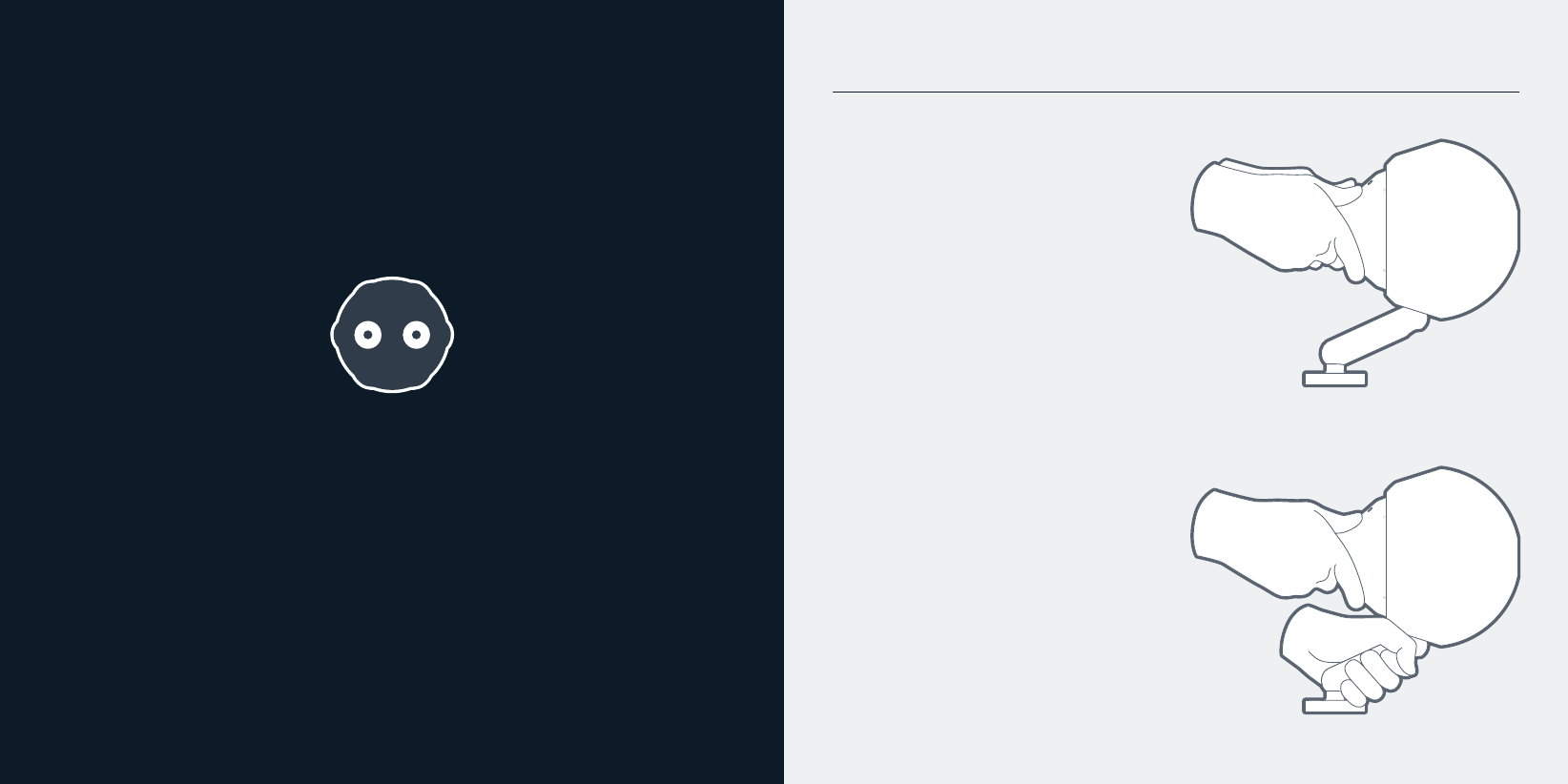
Device Handling
This is the most reliable way of
handling the device.
Lift the device at the “tail” applying
armandsafegrip.
Additionally you can hold the device
by the OZO Tripod adapter if it is
properly attached.
BASICS
15
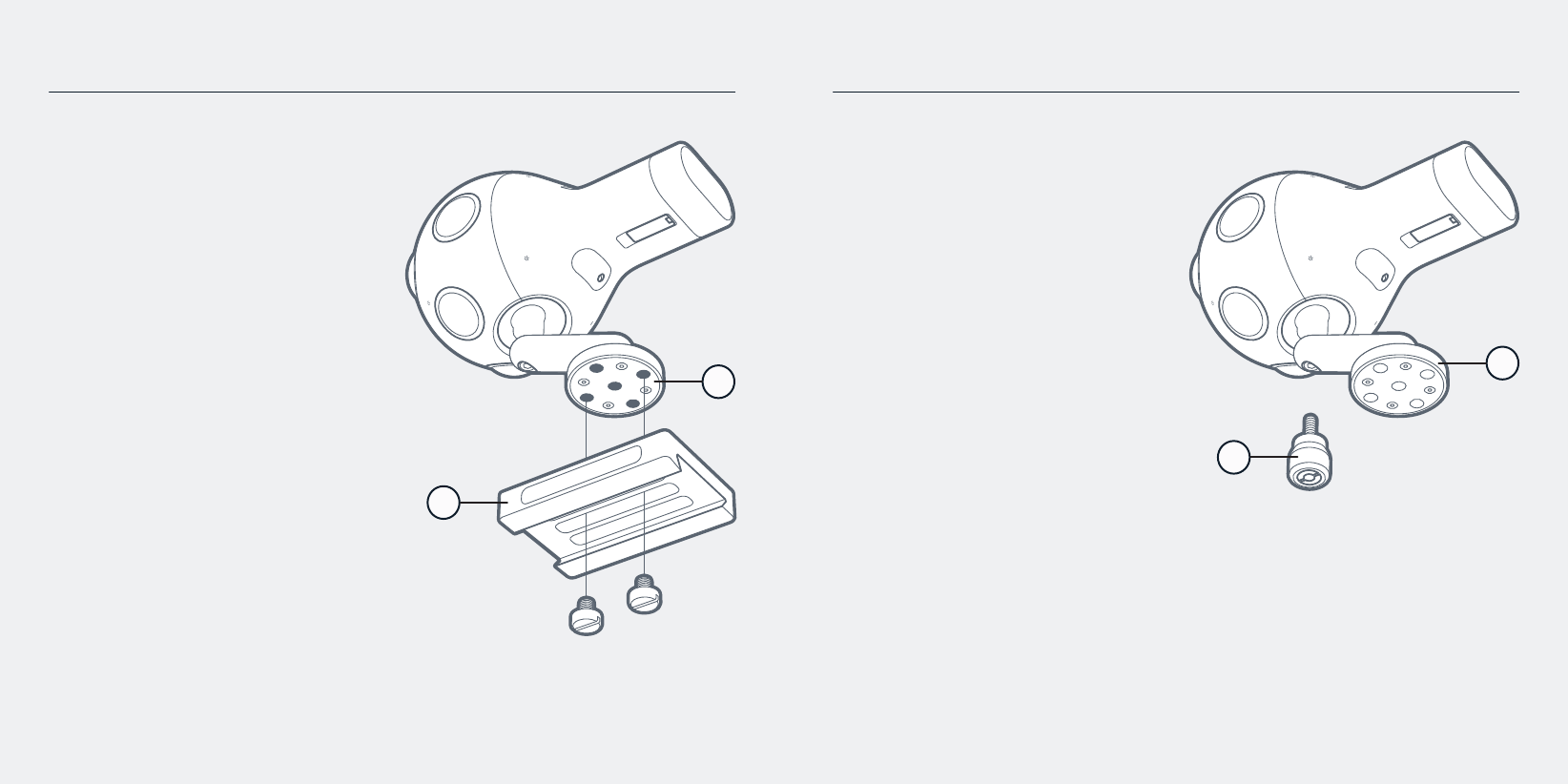
Mounting
Securely mounting a base plate
(A) to the tripod adapter (B) is
recommended.
The Device is delivered with the large
OZO Tripod adapter attached.
The large OZO tripod adapter
includes 5 x standard 3/8” tripod
mounting hole.
The included alternative small OZO
tripod adapter includes 1 x standard
3/8” tripod mounting hole.
B
A
16 Changing the Tripod Adapter
Specic force is required to ensure
the newly-attached tripod adapter is
securely xed.
1. Carefully remove the mounted
adapter (A) using an M8 tool.
2. Attach the alternative adapter (B).
3. Apply exactly 20 Nm with a
torquewrenchtoolandx
securely. Do not overtighten.
Do not replace the M8 screw.
If damaged, always replace with
original spare parts.
17
A
B
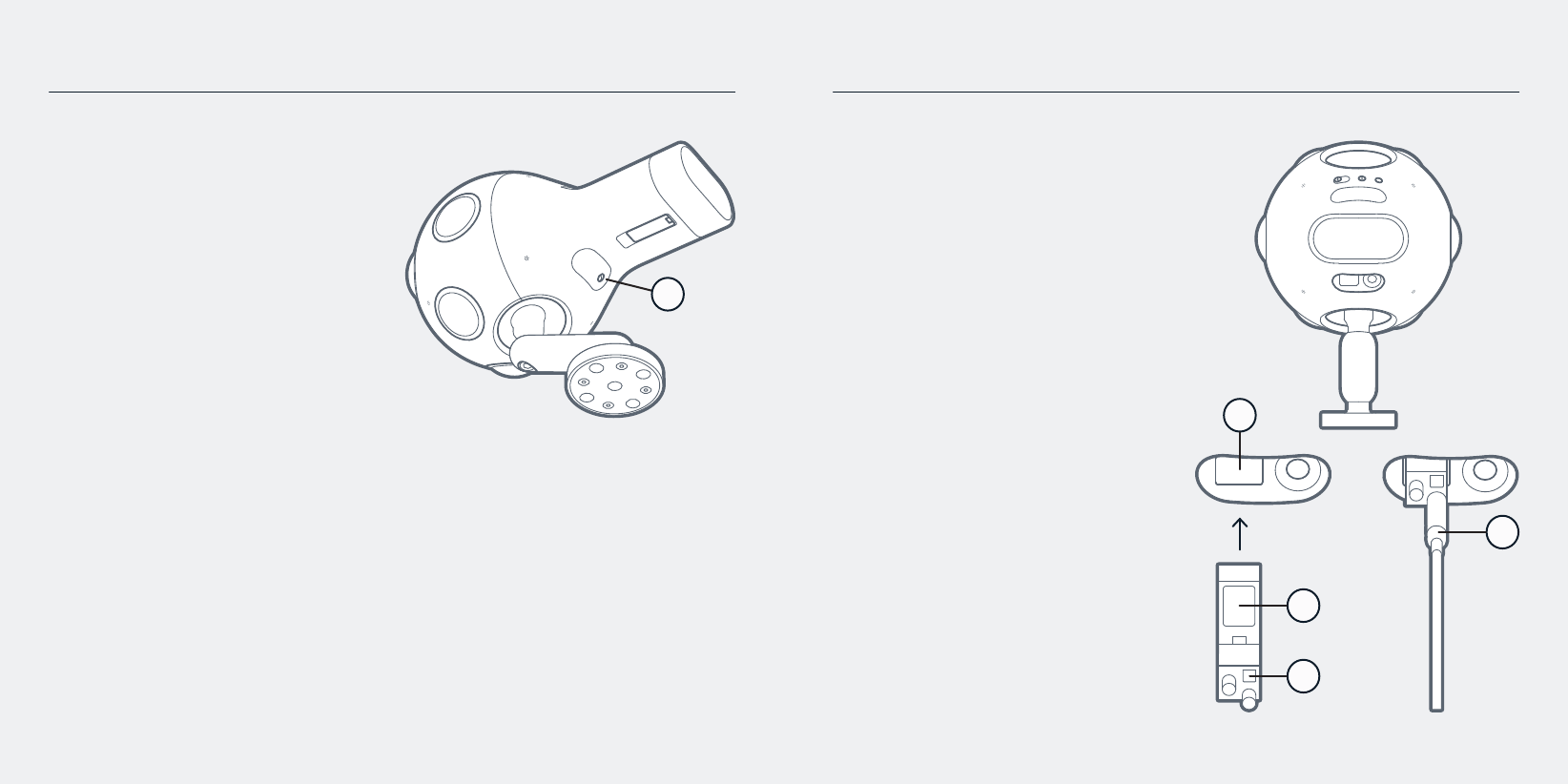
Connector Cap Removal
For streaming data through SDI and
supplying external power, remove
the connector cap (A) located below
the “tail” section by using the
provided T6 Torx tool.
For stand alone use, place the
connector cap back in the slot and
tighten by hand without excessive
torque.
This cap provides basic sealing and
protection for the SDI and power
connectors.
18 Connecting SDI
Attaching 3G-SDI card
Carefully remove the 3G-SDI SFP+
card (A) from the ESD bag, and insert
itrmlyintotheSFP+socket(B).
To remove, lift the latch (C) on the SDI
card and carefully apply backwards
pressure to the frame of card, NOT to
the DIN sockets.
Attaching SDI DIN cable
Attach a standard SDI DIN connector
(D) to the lower DIN socket shown by
arrow facing away from device.
To remove the cable, lift the cover
of the DIN connector, and apply
pressure.
Take care not to apply lateral force to
the DIN sockets. Use cable strain relief
where necessary, otherwise damage
may occur.
19
B
C
A
A
D
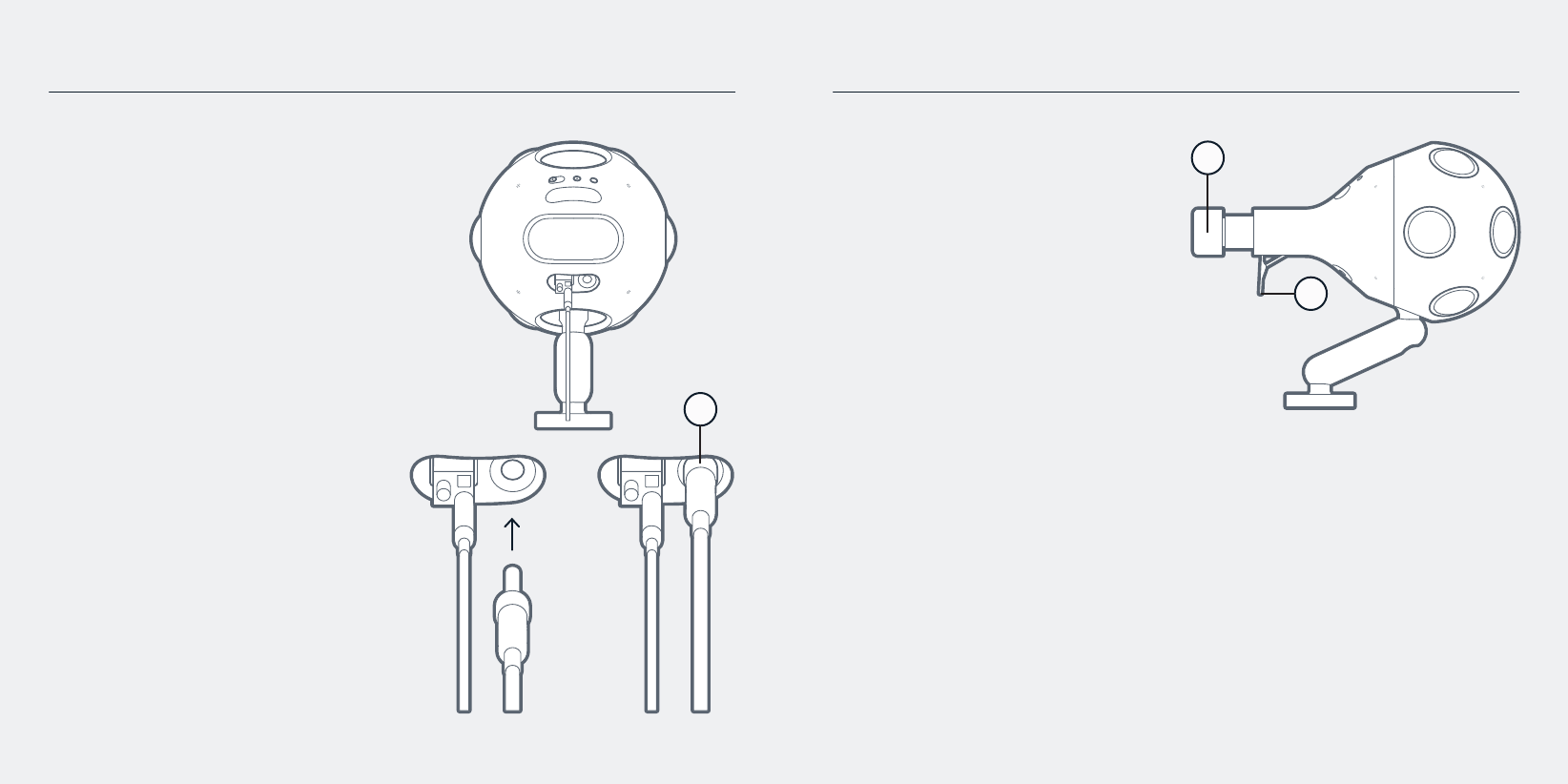
Cartridge Replacement
Before you start make sure the
device is stable and mounted
correctly.
1. Pull the latch (A) to it’s full
extension to release the
cartridge. Do not pull the
cartridge while doing so.
2. Pull the cartridge (B) out (and
closethelatch).
3. To insert the cartridge pull the
latch to it’s full extension.
4. Insert the cartridge with the
groove pointing downwards until
you notice resistance.
5. Release the cartridge and close
the latch.
B
21
Connecting Power
Insert the external power plug into
the device rmly, and rotate the lock
ring (A) clockwise until it is tight.
Always ensure the external plug is
fully inserted, otherwise the device
may not power up, or may use
battery power only.
20
A
A
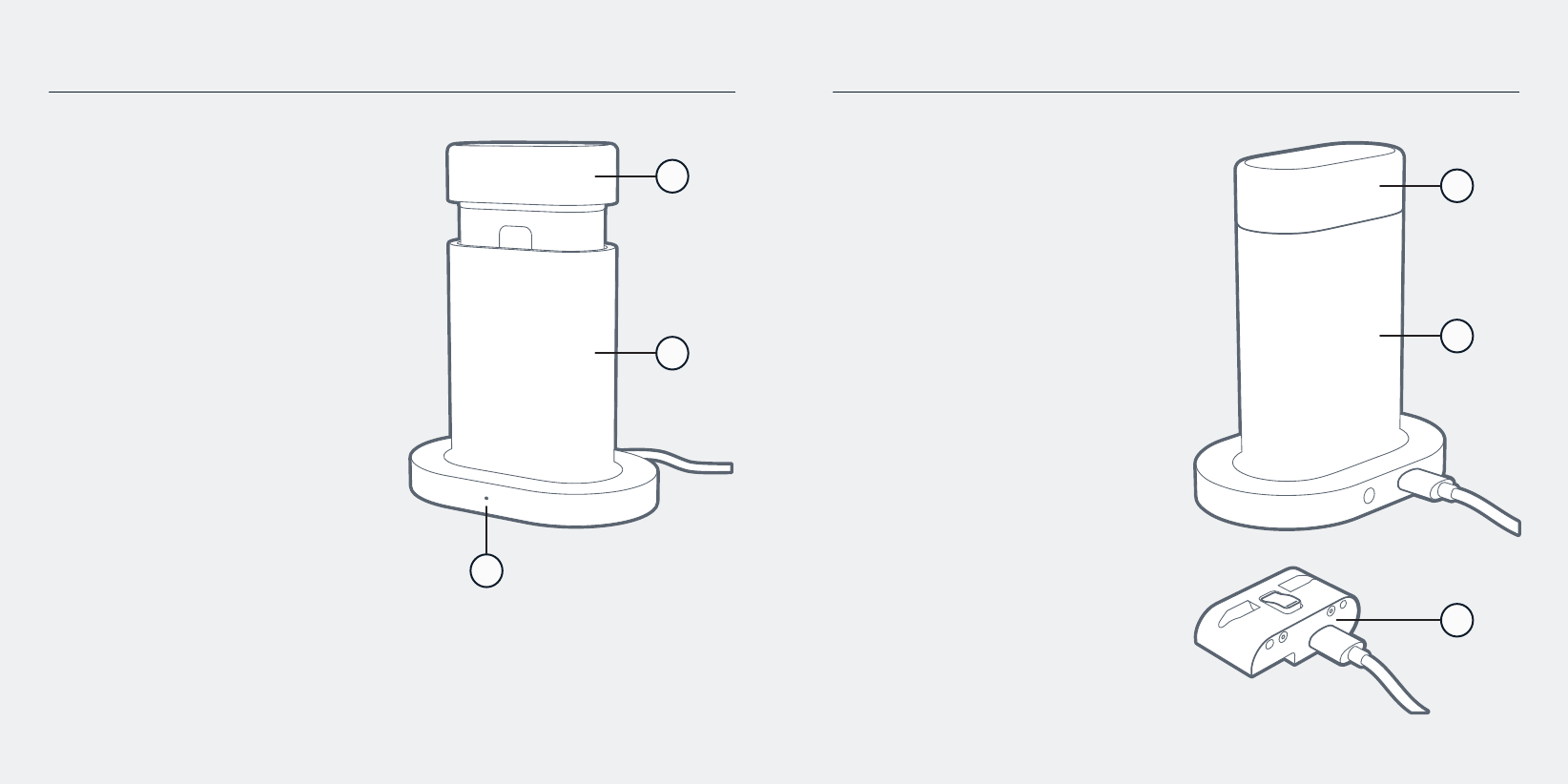
Charging Battery
Insert a Digital Cartridge (A) into the
Docking Station (B).
Ensure a power cable is connected to
the Docking Station.
The LED on the Docking Station (C)
shouldashwhitetoindicatecharging
is in progress, and show solid white
to indicate when the Digital Cartridge
battery is fully charged. Charging an
empty battery can take up to 3 hrs.
A Digital Cartridge must be inserted
at least once to a powered Docking
Station before it can be used in the
device.
A red light indicates a problem.
Slowashingredindicates“No
Battery found”. Solid red indicates
“Cannot charge” (broken or misplaced
battery).Fastashingredindicatesa
malfunction.
22 Extracting Data
Connect the supplied USB cable
from the Docking Station (A) to a
computer with the OZO Creator
application installed. Insert the
Digital Cartridge (B) with a Media
Module inside.
Alternatively, connect the supplied
USB cable directly between a Media
Module (C) and the computer.
23
C
C
A
B
B
A
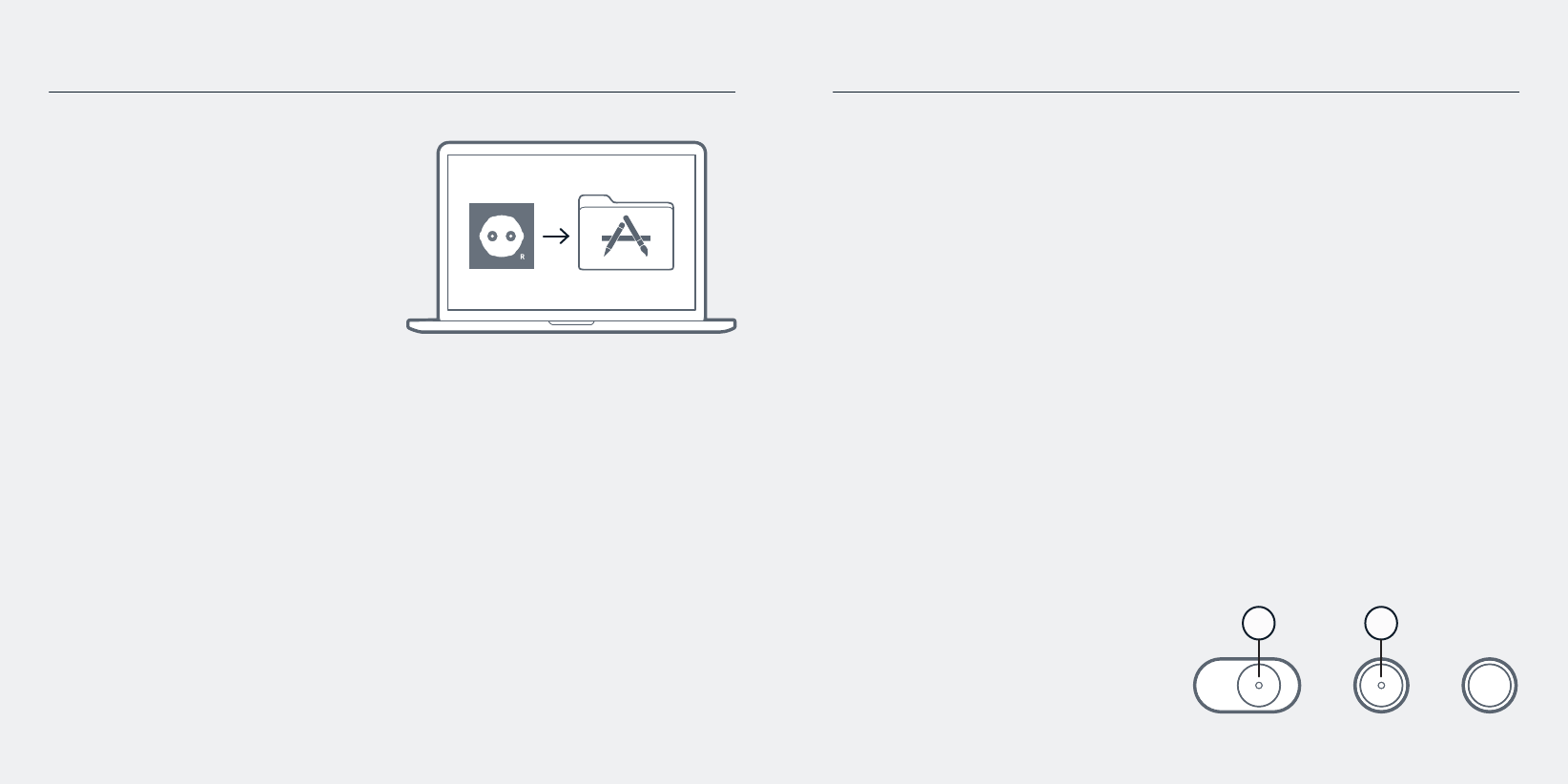
OZO Applications
To download and install the OZO
Applications please follow the
instructions on ozo.nokia.com/start.
The OZO Remote Application is
needed for example to set and
monitor the exposure of the OZO
Camera.
The OZO Creator Application is used
to process and deploy the captured
content to post production tools.
The OZO Preview Application is a tool
to quickly access and view rendered
content like editorials for audio
mixing.
OZO Applications require an Apple
Mac Pro® 6-Core Dual GPU using
OS X 10.10 Yosemite or newer.
24 Basic Operation
Power ON-OFF
To power on the device slide the
power button (A) to the outmost right
position and release. The button will
stay in an intermediate position and
theindicator(LED)inthecenterofthe
button indicates booting (by blinking
slowly).
Oncethebootinghasnishedthe
indicator discontinues blinking and
remains lit. The device always boots
into “Broadcasting” mode to allow
immediate preview over SDI.
For complete shutdown slide the
power button to the outmost left
position.
WiFi
By default the device is enabling WiFi
immediately after booting is complete.
The WiFi-LED (B) is blinking slowly to
indicate readiness to connect.
The OZO Remote host computer
must have WiFi enabled to connect
to the OZO Camera. The WiFi-button
indicator discontinues blinking and
remains lit to indicate a successful
connection to the OZO Remote
Application.
To boot the device without WiFi
(airplanemode)pressandholdthe
WiFi button during startup until
bootinghasnished.
A B
25

Broadcasting over SDI
You can switch from Standby-mode
to Broadcasting either by sliding the
power-button (A) to the outmost right
position and release (as you did for
poweron)orbyusingthecontrolsin
the camera-mode panel of the OZO
Remote Application.
Repeat this procedure to return back
to Standby mode.
During Broadcasting a red LED ring
around the Capture-button blinks
regularly “once in a while” to indicate
that the Camera is “On the Air”.
To monitor the live image from the
Camera make sure the SDI adapter
and cables are connected to your OZO
Remote host computer.
Use the Capture Settings panel in OZO
Remote to set the exposure.
Capturing
Press the Capture button to start or
stop capturing to the internal storage.
While capturing to the internal Media
Module the Capture button indicator
(C) is continuously on. Blinking slowly
signals “less than 5 minutes left”.
Blinking fast signals “storage is full”.
Theselimitsarealsoreectedin
the “Storage” status group in OZO
Remote.
NOTE: To capture on external storage
set the Camera to Broadcasting mode
instead and use the controls on the
external device.
Basic Operation 26
WARRANTY AND LEGAL
A C

WARRANTY, WARRANTY LIMITATIONS AND
WARRANTY DISCLAIMER
Subject to the limitations and disclaimers set
forth below, Nokia warrants that the products
shall be of good quality and free from defects in
material and workmanship. Upon the expiration
of the time periods set forth below, all liabilities
of Nokia will terminate.
Standard Product Warranty
A standard product warranty is granted to the
originalBuyerbyNokiaforaperiodofone(1)
year, parts and labor, for the camera, excluding
thebatteries.(“StandardProductWarranty”)
The standard warranty for batteries is ninety
(90)daysfromthedateofdeliveryoftheprod-
ucts to Buyer. This Standard Product Warranty
covers parts and labor charges for products
that have been returned pre-paid shipment
to Nokia, a Nokia Reseller or Nokia authorized
service center, as directed by Nokia. All warranty
returns shall be done in accordance with Nokia’s
returnmaterialsauthorization(“RMA”)process.
Any repaired or replaced product shall be war-
rantedforaperiodthegreaterof(i)thebalance
of the applicable warranty period relating to
suchProductor(ii)ninety(90)daysafteritis
received by Buyer. Only the components that
were repaired or replaced will be eligible for the
90-day period as set forth above. The Standard
ProductWarrantyeectivedateisthedatethe
product was received by Buyer or Reseller (if
purchasedforReseller’sownuse).
Product Warranty Limitations
All Nokia warranties exclude the following:
1. Maintenance, repair or replacement necessi-
tated by loss or damage resulting from any
cause other than normal use and opera-
tion of the product in accordance with the
Nokia’sspecicationsandproductmanual,
including but not limited to: theft, exposure
to weather conditions, use of the product
underwater or in wet environments, oper-
ator negligence, misuse, abuse, improper
electrical/power supply;
2. Alterations,modicationsorrepairsby
Buyer or unauthorized third parties;
3. Accident, disaster, improper handling or
storage,droppage,modicationtothe
camera, opening the camera body, use third
party accessories or acts of nature or any
other peril originating from outside the
product;
4. Transportation damage (except for trans-
portation damaged in delivery of the prod-
uctstoBuyerfromNokia),lackofmainte-
nance, defective batteries, battery leakage;
5. Cosmetic damage or other non-operating
parts;
6. Using a product in a manner other than
Warranty
intended usage for that product; and
7. Charges related to “No Trouble Found”
diagnosis.
Voiding of Product Warranty
Removalormodicationofcameramounts
voids any and all warranties. Breaking the seal
on the camera body is prohibited and voids any
and all warranties unless otherwise approved
in writing by Nokia. Any parts replaced by Nokia
during warranty repair are the property of Nokia
and will not be returned to Buyer. Nokia may use
refurbished parts for repairs or replacements.
Nokia products are compatible with Nokia soft-
ware, Nokia parts, and Nokia products only. Use
of any software, parts, or products other than
Nokia or Nokia-approved software, parts, and
products voids any and all warranties.
Warranty Disclaimer
EXCEPT AS SPECIFICALLY SET FORTH ABOVE,
NOKIA AND ITS LICENSORS MAKE NO WARRAN-
TIES, CONDITIONS, REPRESENTATION OR TERMS,
EXPRESS OR IMPLIED, WHETHER BY STATUTE,
COMMON LAW, CUSTOM, USAGE OR OTHERWISE
AS TO THE PRODUCT OR ANY COMPONENT
THEREOF, INCLUDING BUT NOT LIMITED TO
NON-INFRINGEMENT OF THIRD PARTY RIGHTS,
INTEGRATION, MERCHANTABILITY, SATISFACTO-
RY QUALITY, OR FITNESS FOR ANY PARTICULAR
PURPOSE. NOKIA AND ITS LICENSORS DO NOT
WARRANT THE PERFORMANCE OR RESULT OF
THE PRODUCT.
THE SOLE REMEDY UNDER THIS WARRANTY
SHALL BE THE REPAIR, REPLACEMENT, OR
CREDIT FOR DEFECTIVE PARTS AS STATED
ABOVE. THIS WARRANTY IS THE SOLE WARRANTY
GIVEN BY NOKIA AND IS IN LIEU OF ANY OTHER
WARRANTIES EITHER EXPRESS OR IMPLIED. THIS
WARRANTY EXTENDS TO THE BUYER AND IS
NON-TRANSFERABLE TO OTHER THIRD PARTIES.
NOKIA WILL NOT BE LIABLE FOR ANY PROPERTY
DAMAGE, LOST TIME, OR LOST DATA RESULT-
ING FROM THE FAILURE OF ANY PRODUCT OR
EQUIPMENT OR FROM DELAYS IN SERVICE OR
THE INABILITY TO RENDER SERVICE.
Third-Party Warranty
Nokia does not honor warranty agreements
extended by third parties, and only warranty
agreements granted and given by Nokia will be
honored by Nokia. Nokia warranties do not cover
damage caused by third party products (includ-
ingapprovedthirdpartyproducts).
Links
The latest product warranty can be found from
https://ozo.nokia.com/. For warranty assistance
please contact OZOsupport@nokia.com.
29

FCC/IC REGULATORY NOTICES
Modication statement
Nokia Technologies Ltd has not approved any
changesormodicationstothisdevicebythe
user.Anychangesormodicationscouldvoid
the user’s authority to operate the equipment.
Nokia Technologies Ltd n’approuve aucune mo-
dicationapportéeàl’appareilparl’utilisateur,
quelle qu’en soit la nature. Tout changement ou
modicationpeuventannulerledroitd’utilisa-
tion de l’appareil par l’utilisateur.
Interference statement
This device complies with Part 15 of the FCC
Rules and Industry Canada licence-exempt RSS
standard(s).Operationissubjecttothefollow-
ingtwoconditions:(1)thisdevicemaynotcause
interference,and(2)thisdevicemustaccept
any interference, including interference that
may cause undesired operation of the device.
LeprésentappareilestconformeauxCNRd’In-
dustrie Canada applicables aux appareils radio
exemptsdelicence.L’exploitationestautorisée
auxdeuxconditionssuivantes:(1)l’appareilne
doitpasproduiredebrouillage,et(2)l’utilisa-
teur de l’appareil doit accepter tout brouillage
radioélectriquesubi,mêmesilebrouillageest
susceptible d’en compromettre le fonctionne-
ment.
Wireless notice
This equipment complies with FCC and IC radi-
ation exposure limits set forth for an uncon-
trolled environment. The antenna should be
installed and operated with minimum distance
of 20 cm between the radiator and your body.
Antenna gain and type must be:
Type Max Gain
Patch antenna 2.6 dBi
This transmitter must not be co-located or
operating in conjunction with any other antenna
or transmitter.
Cet appareil est conforme aux limites d’ex-
position aux rayonnements de l’IC pour un
environnementnoncontrôlé.L’antennedoit
êtreinstalléedefaçonàgarderunedistance
minimale de 20 centimètres entre la source de
rayonnements et votre corps. Gain et Type de
l’antennedoitêtreci-dessous:
Type Gain maximum
Antenne patch 2.6 dBi
L’émetteurnedoitpasêtrecolocalisénifonc-
tionnerconjointementavecàautreantenneou
autreémetteur.
FCC Class B digital device notice
This equipment has been tested and found
to comply with the limits for a Class B digital
device, pursuant to part 15 of the FCC Rules.
Regulatory and Safety Notices
Recycling
The crossed out wheeled bin symbol on your product, battery and/or accessories
meansthattheitemisclassiedaselectricalandelectronicequipment.Suchitems
should not be mixed with general household waste, and must be taken to dedicated
collection points at the end of their working life for proper treatment, recovery and
recycling. This way you help save valuable resources and promote recycling of materials.
31
These limits are designed to provide reasonable
protection against harmful interference in a res-
idential installation. This equipment generates,
uses and can radiate radio frequency energy
and, if not installed and used in accordance with
the instructions, may cause harmful interfer-
ence to radio communications. However, there
is no guarantee that interference will not occur
in a particular installation. If this equipment
does cause harmful interference to radio or
television reception, which can be determined
byturningtheequipmentoandon,theuseris
encouraged to try to correct the interference by
one or more of the following measures:
• Reorient or relocate the receiving antenna.
• Increase the separation between the equip-
ment and receiver.
• Connect the equipment into an outlet on
acircuitdierentfromthattowhichthe
receiver is connected.
• Consult the dealer or an experienced radio/
TV technician for help.
CAN ICES-3 (B) / NMB-3 (B)
This Class B digital apparatus complies with
Canadian ICES-003.
CetappareilnumériquedeclasseBest
conformeàlanormecanadienneICES-003.
Wi-Fi
IMPORTANT: Using Wi-Fi may be restricted in
certain countries or in certain circumstances.
For example, certain countries are currently
considering legislation banning the usage of
WiFi during national states of emergency. For
more information about WiFi usage restrictions
please contact your relevant local authorities.
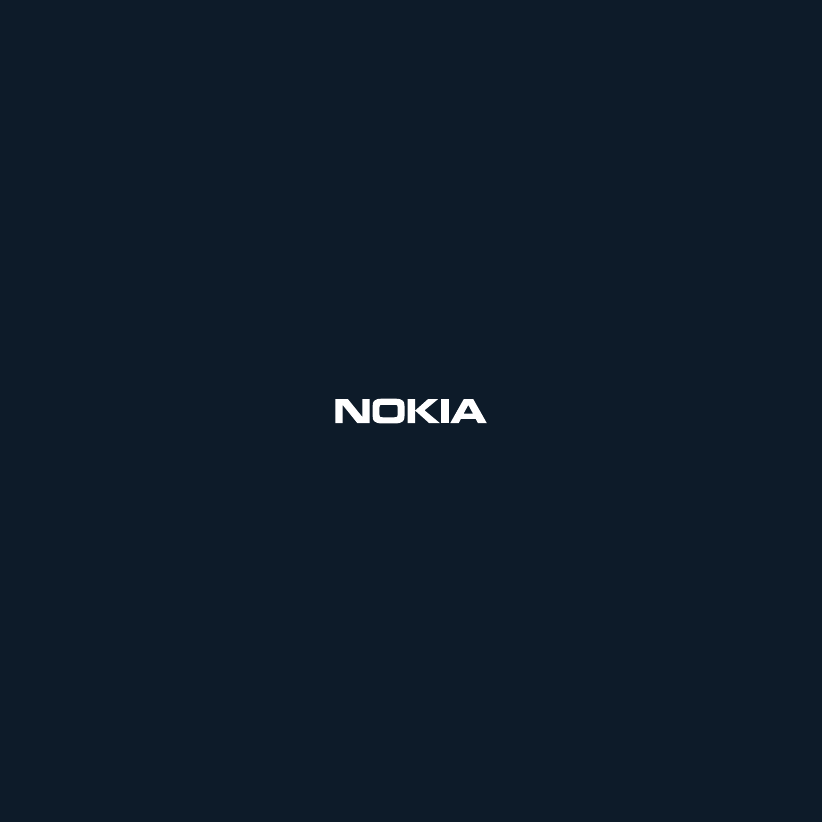
OP100-UC-EN-1.0